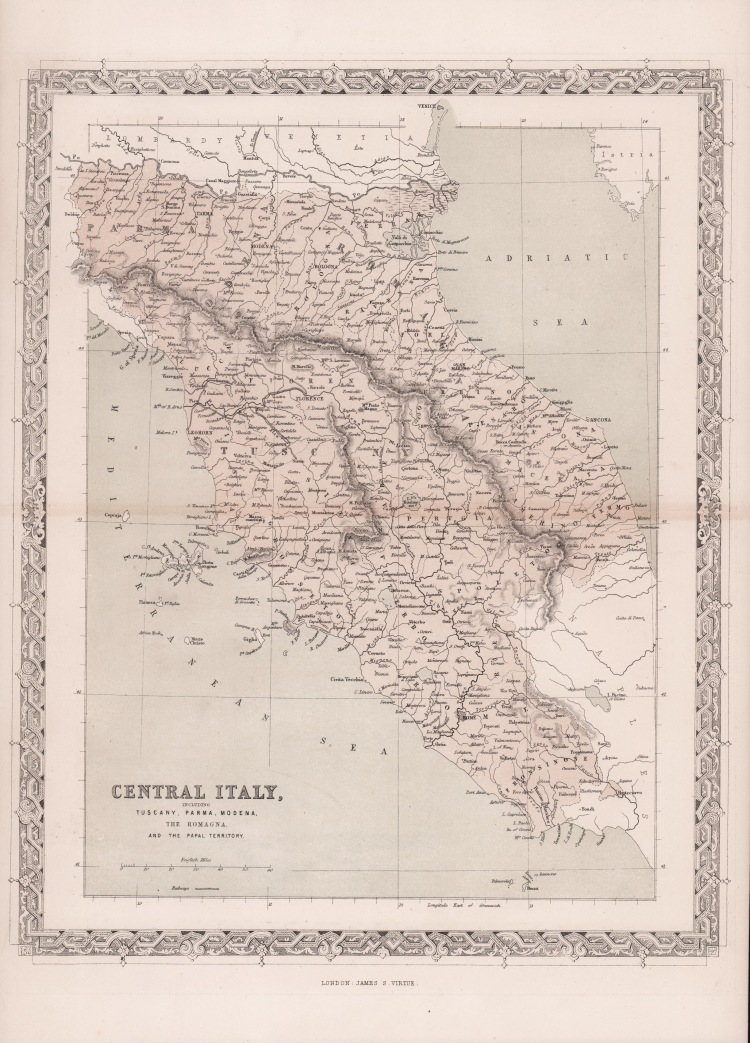



| Riferimento: | CO-750 |
| Autore | George VIRTUE |
| Anno: | 1850 |
| Zona: | Italia centrale |
| Luogo di Stampa: | Londra |
| Misure: | 270 x 340 mm |


| Riferimento: | CO-750 |
| Autore | George VIRTUE |
| Anno: | 1850 |
| Zona: | Italia centrale |
| Luogo di Stampa: | Londra |
| Misure: | 270 x 340 mm |
Carta dell’Italia Centrale e Toscana pubblicata a Londra da George Virtue nel 1850.
“La carta presenta una buona configurazione oro-idrografica, con la rete fluviale ben delineata e correttamente denominata, la catena appenninica e gli altri rilievi montuosi tratteggiati a lumeggiatura zenitale, le città e i centri abitati maggiori ben rappresentati e i relativi tri toponimi quasi sempre corretti. Alquanto incerta appare invece la suddivisione politica, come si percepisce anche dal sottotitolo nel quale si legge including Tuscany, Parma, Modena, the Romagna and the Papal Territory. Difficile dire se si agli tratti di un particolare del tutto occasionale, oppure legato alla temporanea insicurezza politica, conseguente avvenimenti del 1848-49 e della prima guerra d'indipendenza che la carta, stampata nel 1850, cerca di cogliere. Sta di fatto che le denominazioni statuali non sono quelle consuete: Ducato di Parma, di Modena, Granducato di Toscana e Stato della Chiesa, anche se i loro confini restano invariati. L’esemplare, quindi, non appartiene a un "atlantuccio", ma è contenuto in un voluminoso testo di quasi mille pagine, con molte immagini delle maggiori aree del mondo, edito a Londra nel 1850 da George Virtue, con il titolo A Complete and Universal Dictionary of the English Language. L'opera, dalle caratteristiche di un dizionario enciclopedico, era stata avviata nel 1774 dal Rev, James Barclay e continuo a essere pubblicata per oltre 70 anni, con i necessari aggiornamenti e ampliamenti, recando sempre il nome del primo autore e quello del curatore dell'ultima edizione. Nel gergo comune essa veniva anche chiamata Barclay's Universal English Dictionary e, a partire dal 1815, conterrà anche una sezione geografica con relative immagini cartografiche.
Bibliografia
P. Giorgi, C. Cicioni, L’Italia di Mezzo. La cartografia storica del Centro Italia dal XVI al XIX secolo pp. 226-227, n. 94.
George VIRTUE (Londra 1794 - 1868)
|
George C. Virtue (1794 – 8 December 1868) was a 19th-century London-based publisher. His publishing house was located at 26 Ivy Lane, Paternoster Row. Virtue selected accomplished artists, employed the best engravers, and produced books that were rarely surpassed in elegance and correctness for the period. Chief among his publications were the following, all illustrated by William Henry Bartlett: Switzerland, by William Beattie, 2 vols. 1836; Scotland, by W. Beattie, 1838; The Waldenses, by W. Beattie, 1838; American Scenery, 2 vols. 1840; Description of the Beauties of the Bosphorus, by Julia Pardoe, 1840; and The Danube, its History and Scenery, by W. Beattie, 1844. Virtue created a prodigious business, issuing upwards of twenty thousand copper and steel engravings through his career. In 1848, Virtue purchased two magazines. One was an art publication, The Art Union, which had been founded in 1839 by Hodgson & Graves, then purchased in 1847 by Chapman & Hall. The second purchase was controlling interest in Sharpe's London Magazine, a literary and cultural magazine, Arthur Hall publisher. In 1849, Virtue renamed the art magazine The Art Journal and, in time, it became known as the premier art publication of Great Britain. Also in 1849, he created a new firm with Arthur Hall called "Arthur Hall, Virtue & Co."
|
George VIRTUE (Londra 1794 - 1868)
|
George C. Virtue (1794 – 8 December 1868) was a 19th-century London-based publisher. His publishing house was located at 26 Ivy Lane, Paternoster Row. Virtue selected accomplished artists, employed the best engravers, and produced books that were rarely surpassed in elegance and correctness for the period. Chief among his publications were the following, all illustrated by William Henry Bartlett: Switzerland, by William Beattie, 2 vols. 1836; Scotland, by W. Beattie, 1838; The Waldenses, by W. Beattie, 1838; American Scenery, 2 vols. 1840; Description of the Beauties of the Bosphorus, by Julia Pardoe, 1840; and The Danube, its History and Scenery, by W. Beattie, 1844. Virtue created a prodigious business, issuing upwards of twenty thousand copper and steel engravings through his career. In 1848, Virtue purchased two magazines. One was an art publication, The Art Union, which had been founded in 1839 by Hodgson & Graves, then purchased in 1847 by Chapman & Hall. The second purchase was controlling interest in Sharpe's London Magazine, a literary and cultural magazine, Arthur Hall publisher. In 1849, Virtue renamed the art magazine The Art Journal and, in time, it became known as the premier art publication of Great Britain. Also in 1849, he created a new firm with Arthur Hall called "Arthur Hall, Virtue & Co."
|